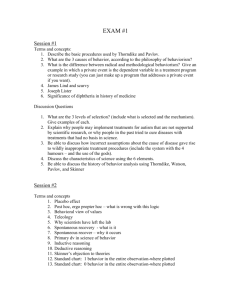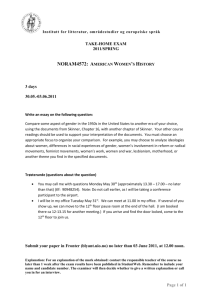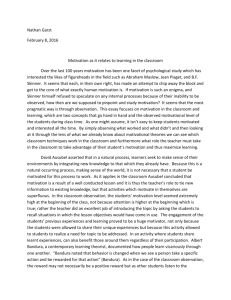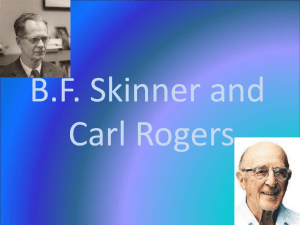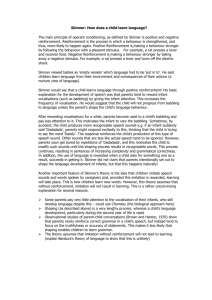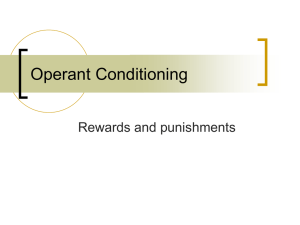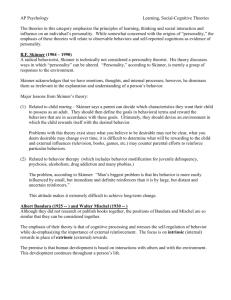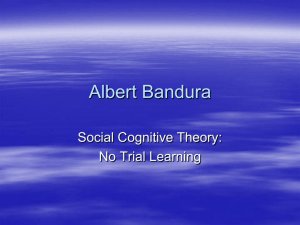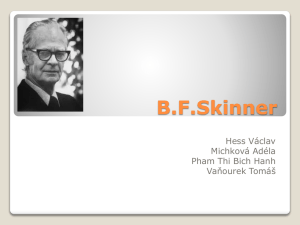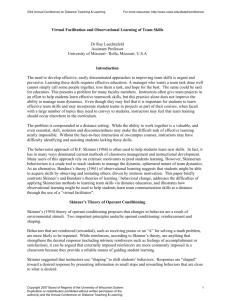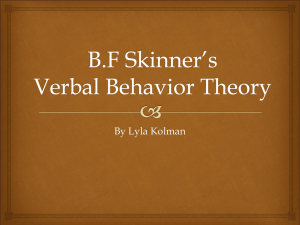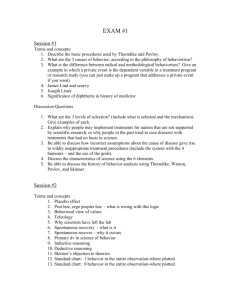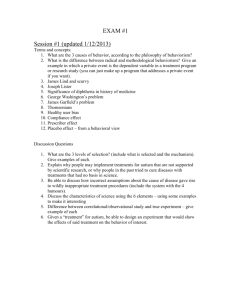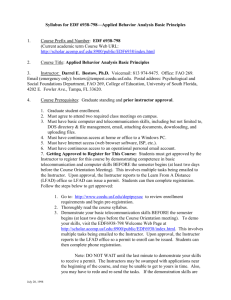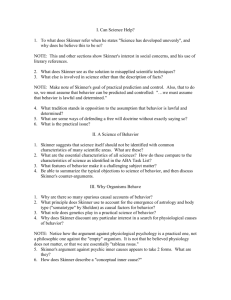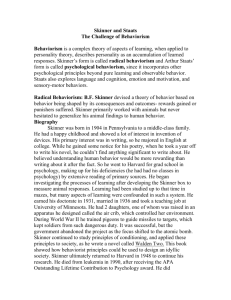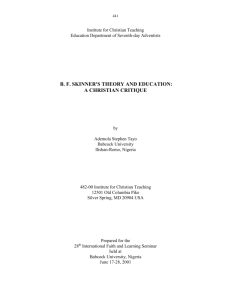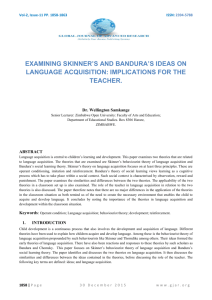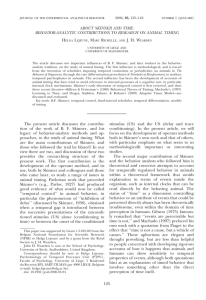Theores of Personality Study Guide for Exam Three
advertisement
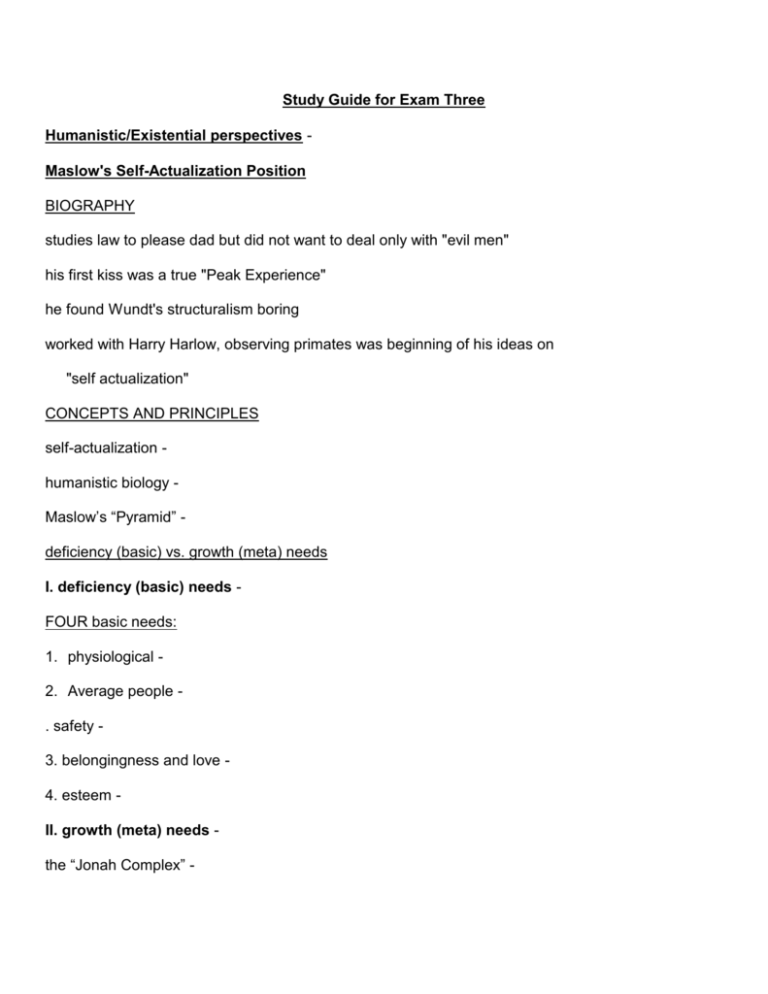
Study Guide for Exam Three Humanistic/Existential perspectives Maslow's Self-Actualization Position BIOGRAPHY studies law to please dad but did not want to deal only with "evil men" his first kiss was a true "Peak Experience" he found Wundt's structuralism boring worked with Harry Harlow, observing primates was beginning of his ideas on "self actualization" CONCEPTS AND PRINCIPLES self-actualization humanistic biology Maslow’s “Pyramid” deficiency (basic) vs. growth (meta) needs I. deficiency (basic) needs FOUR basic needs: 1. physiological 2. Average people . safety 3. belongingness and love 4. esteem II. growth (meta) needs the “Jonah Complex” - Hyland’s view “desacralizing” attitude D-cognition vs. B-cognition 1. D2. BPeak experiences B“Flow” Maslow’s study of “self actualizers” identifying self actualizers ASSESSMENT TECHNIQUES Personal Orientation Inventory (POI) THEORY'S IMPLICATIONS FOR THEREAPY neurotics Applied value Industrial Organizational Psychology - Roger's Person-Centered Theory BIOGRAPHY raised in a warm family and attended Union Theological Seminary held several positions and resigned from Univ. of Wisconsin when they denied the academic reforms he called for served as president of the APA CONCEPTS AND PRINCIPLES Phenomenological field self actualizing tendency (has biological and psychological aspects) biological aspects psychological aspects organismic valuing process Davis (1928) Criticisms of Davis: gestures may have been misinterpreted by nurses sample of only three babies was too small none of the foods were really lacking in nutritional value the “animal” literature does not support the organismic valuing process fully functioning persons are living “in the present” trust their instincts are creative and live rich lives trust their own experience and distrust authority emerging persons social self vs. true self social self true self need for positive regard conditions of worth - conditional positive regard unconditional positive regard lack of “congruence” “subceived” threat ASSESSMENT TECHNIQUES the Q Sort technique THEORY'S IMPLICATIONS FOR THEREAPY “Person Centered Therapy” Therapy is “Nondirective”Mrs. Oak Researchers such as Eysenck have questioned the validity of the therapy research done by humanists. Roger’s views on education Roger’s views on marriage Satellite relationships Applied value - May' Existential-Analytic Position BIOGRAPHY like Rogers, he attended Union Theological Seminary became interested in existentialist philosophy contracted tuberculosis and was close to death several times CONCEPTS AND PRINCIPLES existentialism “Dasein” ”ontology “Being” May and other existentialists criticized: 1. Kurt Lewin (and others) 2. Rogers 3. Skinner “nothingness” “suicide” May’s existential-analytic perspective Freud’s “reductionism” Three modes of “being” in the world 1. unwelt 2. mitwelt 3. eigenwelt modern society emptiness and loneliness unhealthy communal orientation healthy communal orientation Anxiety ontological anxiety 1. normal anxiety - 2. neurotic anxiety ASSESSMENT TECHNIQUES therapy THEORY'S IMPLICATIONS FOR THERAPY goal of therapy - B.F. Skinner's Operant Analysis BIOGRAPHY had a fascination with mechanical objects and invented the Skinner box unlike Watson, he felt that psychologists could study "internal events" so long as it was done scientifically E.L. Thorndike and his law of effect inspired Skinner's "operant analysis" approach CONCEPTS AND PRINCIPLES Skinner distinguished mentalism from cognition “mentalism” “cognition” - i Skinner vs. Watson on the study of “internal events” Watson Skinner mentalism a "Functional Analysis" Environmental determinism "personality" - Operant Conditioning contingencies reinforcement punishment positive punishment negative punishment reinforcement Skinner’s view on punishment (3 points) 1. 2. 3. THEORY'S IMPLICATIONS FOR THEREAPY Allyon and Azrin’s study with schizophrenics Example of the use of aversive techniques Ryckman’s (text author) view on the use of punishment THEORY'S IMPLICATIONS FOR SOCIETY Walden Two - Skinner’s utopian society 1. 2. 3. 4. 5. 6. Humanistic/Existential (Rogers/May) reactions to Skinner’s ideas - Rotter’s Expectancy-Reinforcement BIOGRAPHY was influenced by Adler more importantly, he sought to combine Hullian “Drive Reduction Theory” and Operant learning theory with Kurt Lewin’s “Field Theory” drive reduction theory field theory The “locus of control” concept has clearly been his most significant contribution CONCEPTS AND PRINCIPLES 1. “behavior potential” 2. “expectancy” 3. “reinforcement value” 4. “psychological situation” 5. “freedom of movement” High Low 6. “minimal goal” PERSONALITY DEVELOPMENT Development: rejection overindulgence - ASSESSMENT TECHNIQUES Internal vs. External locus of control I-E scale down side to having an internal locus of control THEORY’S IMPLICATIONS FOR THEREAPY In general, disturbed people elicit negative reactions from others because of how they behave. Behaviors are a function of beliefs (cognitions) so a variety of cognitive and/or behavioral methods would be indicated. Heuristic value - Bandura’s Social-Cognitive Theory BIOGRAPHY while at Stanford University, he developed his “social cognitive approach” he has done much research into the determinants of aggressive behavior “self efficacy” is another one of his important concepts CONCEPTS AND PRINCIPLES triadic reciprocal determinism anticipated outcomes observational learning Bandura’s Bobo Doll Study Phase 1 - three groups of children saw aggressive film A. control group B. reward group - C. punishment group Result Phase 2 Result Bandura says Violent video games and aggression Regarding violence in the media, Bandura recommends that: 1. parents and others encourage media executives create more constructive shows and video games 2. parents monitor and control their children’s access to media violence Efficacy expectations Four sources of information and relative importance in determining “efficacy expectations” 1. Performance accomplishments 2. Vicarious experiences 3. Verbal persuasion 4. Emotional arousal level ASSESSMENT TECHNIQUES Bandura relies on the “experimental method,” demonstrating that manipulation of “antecedent events” (environmental conditions) can alter cognitions which can in turn alter behavior THEORY’S IMPLICATIONS FOR THERAPY Modeling - Bandura and Menlove (1968) guided participation modeling simply watching (observing) a model demonstrating effective coping is NOT as effective as guided participation modeling Applied value - John Dollard and Neal Miller BOIGRAPHY Neal Miller - received his degree from Yale and studies with the famous learning theorist Clark Hull. Well known for his work with biofeedback and animal models of human behavior. He was also president of the APA. John Dollard THEORY AND CONCEPTS A good attempt to explain Freudian concepts such as repression and displacement in terms of learning (drive reduction) theory in an attempt to reconcile the two viewpoints Four concepts of Clark Hull’s “drive reduction theory” 1. drive 2. cue 3. response 4. reinforcement reinforcement theory hierarchy of responses “dominant response” - the "learning dilemma" 1. a primary punisher (shock) is associated with a neutral stimulus (white compartment) 2. fear becomes an acquired drive (CER or conditioned fear reaction) 3. any response that lowers fear is reinforcing so its "habit strength" increases 4. feared stimulus (white compartment) is avoided so the rat never learns that the danger is no longer present (basis of phobic avoidance) Types of "conflict" 1. approach-approach 2. avoidance-avoidance 3. approach-avoidance 4. double approach-avoidance factors that influence the reaching of a goal (e.g., asking for a raise) 1. avoidance gradient is “steeper” than approach gradient (in an approach-avoidance conflict, as you get closer, drive to avoid increases more quickly than drive to approach) 2. vacillation (indecision) 3. increased drive Miller’s demonstration of “displacement” using rats and a doll 1. When two rats were placed in a cage with a doll and shocked, they attacked each other and ignored the doll. 2. When one rat was removed, the remaining rat attacked the doll. Aggression was displaced to a similar target. frustration-aggression hypothesis - The Unconscious Mind 1. Experiences that were never verbalized - experiences during the first year or two of life may make a strong impression. But, because language has not yet been learned the experiences were never verbalized or "labeled" and never can be, thus they remain "unconscious". 2. Suppression 3. Repression 4. "STUPID" behaviors psychotherapy Berkun and Murray experiment (psychotherapy for shocked rats) 1. rats were shocked so they learned to fear a white compartment 2. they were then repeatedly placed in an apparatus with connecting white, gray, and black runways each with a food goal 3. at first they moved (displaced) quickly to the black runway (most dissimilar to the white) 4. with continued trials, they reached the food goal in the gray runway and eventually in the white runway which they initially feared. The fear had extinguished. Theory and Research in Contemporary Personality Psychology grand theories of personality biological approaches Behavior Genetics Evolutionary Theory - "Differential Parental Investment Hypothesis" 1. males prefer many mates whereas females are more selective 2. females are more "invested" in offspring because of the "nine month" vs. "nine minute" difference involved in procreation Some other mating differences: 1. youth, clear skin, lustrous hair, symmetry, etc. suggest greater reproductive ability 2. for a male, an attractive mate is a sign of "status" 3. males are concerned primarily with sexual infidelity whereas females are concerned primarily with emotional infidelity the "Multicultural Perspective" Androgynous role religion and personality The Five Factor Model 1. The factor labels are not fully agreed upon (e.g., some insist on calling extraversion "surgency" 2. In contrast, the label "emotional stability/neuroticism is almost universally agreed upon 3. Factor analyses by researchers such as Paunonen and Jackson (2000) suggest more than five factors 4. Ryckman suggests that the Big Five are at present "Primarily Descriptive" and that they need to be linked to explanatory theoretical frameworks such as Eysenck's Positive Psychology Humanists Seligman and Mr. C - "forgiveness" "self control" Life Story Techniques -

